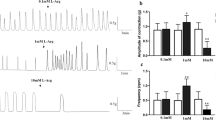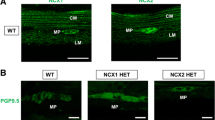Abstract
Purpose
The underlying mechanism responsible for motility changes in colonic diverticular disease (DD) is still unknown. In the present study, our aim was to investigate the structural and in vitro motor changes in the sigmoid colon of patients with DD.
Methods
Muscle bath, microelectrodes and immunohistochemical techniques were performed with samples obtained from the left and sigmoid colon of patients with DD and compared with those of patients without DD.
Results
The amplitude and area under the curve of the spontaneous rhythmic phasic contractions were greatly reduced in patients with DD whereas their frequency and tone remained unaltered. Electrical field stimulation induced a neurally mediated, enhanced ON-contraction (amplitude) in patients with DD and increased the duration of latency of OFF-contractions. The resting membrane potential of smooth muscle cells was hyperpolarized and the amplitude of the inhibitory junction potential was increased in patients with DD. In contrast, no significant histological differences were observed in patients with DD as smooth muscle (circular and longitudinal layers), interstitial cells of Cajal, glial cells and myenteric neurons densities remained unaltered.
Conclusions
Sigmoid strips from patients with asymptomatic DD showed an altered motor pattern with reduced spontaneous motility and enhanced neurally mediated colonic responses involving both excitatory and inhibitory motor pathways. No major neural and muscular structural elements were detected at this stage of the disease. These findings could be valuable in understanding the pathophysiology of this prevalent digestive disease.





Similar content being viewed by others
References
Matrana MR, Margolin DA (2009) Epidemiology and pathophysiology of diverticular disease. Clin Colon Rectal Surg 22(3):141–146
Whiteway J, Morson BC (1985) Elastosis in diverticular disease of the sigmoid colon 13. Gut 26(3):258–266
Golder M, Burleigh DE, Ghali L et al (2007) Longitudinal muscle shows abnormal relaxation responses to nitric oxide and contains altered levels of NOS1 and elastin in uncomplicated diverticular disease. Colorectal Dis 9(3):218–228
Mimura T, Bateman AC, Lee RL et al (2004) Up-regulation of collagen and tissue inhibitors of matrix metalloproteinase in colonic diverticular disease7. Dis Colon Rectum 47(3):371–378
Thomson HJ, Busuttil A, Eastwood MA, Smith AN, Elton RA (1987) Submucosal collagen changes in the normal colon and in diverticular disease11. Int J Colorectal Dis 2(4):208–213
Huizinga JD, Waterfall WE, Stern HS (1999) Abnormal response to cholinergic stimulation in the circular muscle layer of the human colon in diverticular disease 9. Scand J Gastroenterol 34(7):683–688
Tomita R, Fujisaki S, Tanjoh K, Fukuzawa M (2000) Role of nitric oxide in the left-sided colon of patients with diverticular disease 7. Hepatogastroenterology 47(33):692–696
Bassotti G, Battaglia E, Spinozzi F, Pelli MA, Tonini M (2001) Twenty-four hour recordings of colonic motility in patients with diverticular disease: evidence for abnormal motility and propulsive activity 1. Dis Colon Rectum 44(12):1814–1820
Trotman IF, Misiewicz JJ (1988) Sigmoid motility in diverticular disease and the irritable bowel syndrome 7. Gut 29(2):218–222
Sarna SK (2006) Molecular, functional, and pharmacological targets for the development of gut promotility drugs. Am J Physiol Gastrointest Liver Physiol 291(4):G545–G555
Rao SS, Sadeghi P, Beaty J, Kavlock R, Ackerson K (2001) Ambulatory 24-h colonic manometry in healthy humans. Am J Physiol Gastrointest Liver Physiol 280(4):G629–G639
Auli M, Martinez E, Gallego D et al (2008) Effects of excitatory and inhibitory neurotransmission on motor patterns of human sigmoid colon in vitro. Br J Pharmacol 155(7):1043–1055
Maselli MA, Piepoli AL, Guerra V et al (2004) Colonic smooth muscle responses in patients with diverticular disease of the colon: effect of the NK2 receptor antagonist SR48968. Dig Liver Dis 36(5):348–354
Huizinga JD (1986) Electrophysiology of human colon motility in health and disease14. Clin Gastroenterol 15(4):879–901
Jeyarajah S, Papagrigoriadis S (2011) Review article: the pathogenesis of diverticular disease—current perspectives on motility and neurotransmitters. Aliment Pharmacol Ther 33(7):789–800
Bassotti G, Battaglia E, Bellone G et al (2005) Interstitial cells of Cajal, enteric nerves, and glial cells in colonic diverticular disease 5. J Clin Pathol 58(9):973–977
Vuong NP, Sezeur A, Balaton A, Malafosse M, Camilleri JP (1985) Myenteric plexuses and colonic diverticulosis: results of a histological study. Gastroenterol Clin Biol 9(5):434–436
Iwase H, Sadahiro S, Mukoyama S, Makuuchi H, Yasuda M (2005) Morphology of myenteric plexuses in the human large intestine: comparison between large intestines with and without colonic diverticula. J Clin Gastroenterol 39(8):674–678
Deduchovas O, Saladzinskas Z, Tamelis A et al (2008) Morphologic pattern of myenteric neural plexus in colonic diverticular disease. A whole-mount study employing histochemical staining for acetylcholinesterase. Ann Anat 190(6):525–530
Wedel T, Busing V, Heinrichs G et al (2010) Diverticular disease is associated with an enteric neuropathy as revealed by morphometric analysis. Neurogastroenterol Motil 22(4):407–4
Gallego D, Gil V, Aleu J et al (2008) Purinergic and nitrergic junction potential in the human colon. Am J Physiol Gastrointest Liver Physiol 295(3):G522–G533
Gallego D, Auli M, Aleu J et al (2010) Effect of otilonium bromide on contractile patterns in the human sigmoid colon. Neurogastroenterol Motil 22(6):e180–e191
Golder M, Burleigh DE, Belai A et al (2003) Smooth muscle cholinergic denervation hypersensitivity in diverticular disease. Lancet 361(9373):1945–1951
Gallego D, Hernandez P, Clave P, Jimenez M (2006) P2Y1 receptors mediate inhibitory purinergic neuromuscular transmission in the human colon3. Am J Physiol Gastrointest Liver Physiol 291(4):G584–G594
Gallego D, Clave P, Donovan J et al (2008) The gaseous mediator, hydrogen sulphide, inhibits in vitro motor patterns in the human, rat and mouse colon and jejunum. Neurogastroenterol Motil 20(12):1306–1316
Parks TG, Connell AM (1969) Motility studies in diverticular disease of colon. I. Basal activity and response to food assessed by open-ended tube and miniature balloon techniques. Gut 10(7):534
Cortesini C, Pantalone D (1991) Usefulness of colonic motility study in identifying patients at risk for complicated diverticular disease. Dis Colon Rectum 34(4):339–342
Bernard CE, Gibbons SJ, Gomez-Pinilla PJ et al (2009) Effect of age on the enteric nervous system of the human colon. Neurogastroenterol Motil 21(7):746–e46
Gomez-Pinilla PJ, Gibbons SJ, Sarr MG et al (2011) Changes in interstitial cells of cajal with age in the human stomach and colon. Neurogastroenterol Motil 23(1):36–44
Keranen U, Jarvinen H, Kiviluoto T, Kivilaakso E, Soinila S (1996) Substance P- and vasoactive intestinal polypeptide-immunoreactive innervation in normal and inflamed pouches after restorative proctocolectomy for ulcerative colitis. Dig Dis Sci 41(8):1658–1664
Neunlist M, Aubert P, Toquet C et al (2003) Changes in chemical coding of mysenteric neurones in ulcerative colitis. Gut 52(1):84–90
Acknowledgements
The authors thank Dra. MJ Fantova and Dra. C Admella (Department of Pathology Hospital de Mataró), Dr. J. Martí-Ragué, A Sáenz, M Marti-Gallostra and J. Cases (Clínica Sagrada Familia) and Dr. X Suñol, O Estrada, A Heredia, E García and L A Hidalgo (Hospital de Mataró) for providing human tissue samples, and Mrs. Jane Lewis for revising the manuscript.
Grants
This study was supported by grants from: Salut del Consorci Santari del Maresme, Laboratorios Menarini SA, the Ministerio de Ciencia e Innovación (Fondo de Investigación Sanitaria IF063678-1, INT 10/228), BFU2009-11118, the Centro de Investigación Biomédica en Red de Enfermedades Hepáticas y Digestivas (Ciberehd), Instituto de Salud Carlos III and the Agencia de Gestió d’Ajuts Universitaris i de Recerca (2009 SGR 708). Diana Gallego is funded by CIBERehd (Centro de Investigación Biomédica en Red de Enfermedades Hepáticas y Digestivas, Instituto de Salud Carlos III) and Victor Gil is supported by the Ministerio de Ciencia e Innovación (Spain) (AP2007-01583).
Conflicts of interest
Prof. P Clavé received lecture fees and travel grants from Menarini Richerche, Diana Gallego received travel grants from Menarini Richerche. Francisco Espin, Jan Mikulka, Ondřej Šmirg, Víctor Gil, Marcos Faundez-Zanuy and Marcel Jiménez reported no biomedical financial interests or potential conflicts of interest.
Author information
Authors and Affiliations
Corresponding author
Rights and permissions
About this article
Cite this article
Gallego, D., Espín, F., Mikulka, J. et al. In vitro motor patterns and electrophysiological changes in patients with colonic diverticular disease. Int J Colorectal Dis 28, 1413–1422 (2013). https://doi.org/10.1007/s00384-013-1716-7
Accepted:
Published:
Issue Date:
DOI: https://doi.org/10.1007/s00384-013-1716-7




